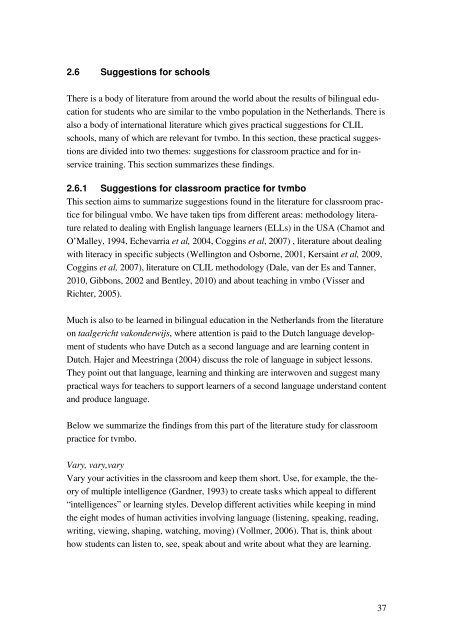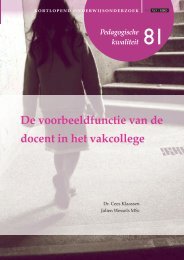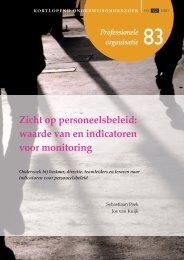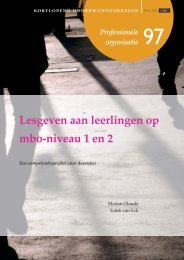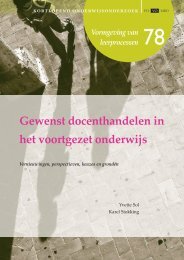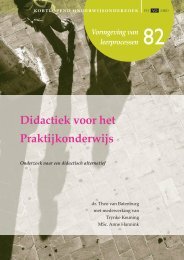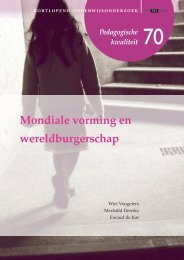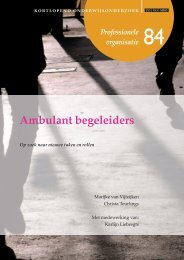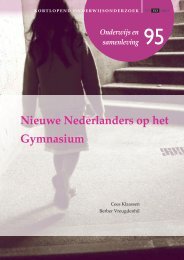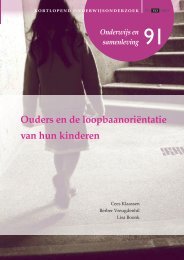Proud to be tvmbo - Kortlopend Onderwijsonderzoek
Proud to be tvmbo - Kortlopend Onderwijsonderzoek
Proud to be tvmbo - Kortlopend Onderwijsonderzoek
You also want an ePaper? Increase the reach of your titles
YUMPU automatically turns print PDFs into web optimized ePapers that Google loves.
2.6 Suggestions for schools<br />
There is a body of literature from around the world about the results of bilingual education<br />
for students who are similar <strong>to</strong> the vmbo population in the Netherlands. There is<br />
also a body of international literature which gives practical suggestions for CLIL<br />
schools, many of which are relevant for <strong>tvmbo</strong>. In this section, these practical suggestions<br />
are divided in<strong>to</strong> two themes: suggestions for classroom practice and for inservice<br />
training. This section summarizes these findings.<br />
2.6.1 Suggestions for classroom practice for <strong>tvmbo</strong><br />
This section aims <strong>to</strong> summarize suggestions found in the literature for classroom practice<br />
for bilingual vmbo. We have taken tips from different areas: methodology literature<br />
related <strong>to</strong> dealing with English language learners (ELLs) in the USA (Chamot and<br />
O’Malley, 1994, Echevarria et al, 2004, Coggins et al, 2007) , literature about dealing<br />
with literacy in specific subjects (Welling<strong>to</strong>n and Osborne, 2001, Kersaint et al, 2009,<br />
Coggins et al, 2007), literature on CLIL methodology (Dale, van der Es and Tanner,<br />
2010, Gibbons, 2002 and Bentley, 2010) and about teaching in vmbo (Visser and<br />
Richter, 2005).<br />
Much is also <strong>to</strong> <strong>be</strong> learned in bilingual education in the Netherlands from the literature<br />
on taalgericht vakonderwijs, where attention is paid <strong>to</strong> the Dutch language development<br />
of students who have Dutch as a second language and are learning content in<br />
Dutch. Hajer and Meestringa (2004) discuss the role of language in subject lessons.<br />
They point out that language, learning and thinking are interwoven and suggest many<br />
practical ways for teachers <strong>to</strong> support learners of a second language understand content<br />
and produce language.<br />
Below we summarize the findings from this part of the literature study for classroom<br />
practice for <strong>tvmbo</strong>.<br />
Vary, vary,vary<br />
Vary your activities in the classroom and keep them short. Use, for example, the theory<br />
of multiple intelligence (Gardner, 1993) <strong>to</strong> create tasks which appeal <strong>to</strong> different<br />
“intelligences” or learning styles. Develop different activities while keeping in mind<br />
the eight modes of human activities involving language (listening, speaking, reading,<br />
writing, viewing, shaping, watching, moving) (Vollmer, 2006). That is, think about<br />
how students can listen <strong>to</strong>, see, speak about and write about what they are learning.<br />
37


